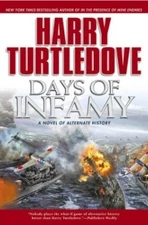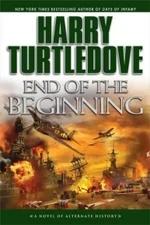| 2nd Battle of the North Pacific | |||||||
|---|---|---|---|---|---|---|---|
| Part of World War II, | |||||||
|
|||||||
| Belligerents | |||||||
| United States | Japan | ||||||
| Commanders and leaders | |||||||
| ??? | Tomeo Kaku |
||||||
The 2nd Battle of the North Pacific was the third major fleet engagement of the Pacific War in World War 2. After the disastrous loss the year before in the 1st Battle of the North Pacific, the United States refused to give up until they had completely defeated the Japanese. This led to another naval battle for the Hawaiian Islands. Having learnt valuable lessons the year before, the US Navy struck at the Japanese fleet guarding Hawaii with the largest fleet history had ever seen. The small task force defending Hawaii was effectively wiped out, paving the way for the Liberation of Hawaii by the US Marines and Army.
Background
After the US Navy's defeat in the 1st Battle of the North Pacific, they withdrew to the US West Coast to lick their wounds. Although down, the US was not out and made it clear that they would return. Having learnt valuable lessons in that battle, they transferred all their carriers from the Atlantic to the Pacific. US ship builders also pumped out new fleet carriers, the Bunker Hill, Essex, Wasp, and Ranger. Along with the repaired Hornet, several Light Carriers and close to a dozen Escort Carriers, the US Navy was building a big fist in which to strike at Japan. Japan's situation on the other hand was rather precarious. They had only launched one new fleet carrier and she wouldn't be ready to fight for another year. The US submarine war on the Hawaiian islands was also cutting the vital supply of fuel needed to train the replacement pilots, all of whom where dangerously green. On top of that, the defeats the Germans had suffered in North Africa mean that the British could pull at them from the West, while down in Australia, the US Army Air Force was beginning to bite back, stretching Japan's limited resources thin. Japan's fortunes were further shot when Zuikaku was damaged by a submarine attack as she was returning to join the fleet. This left the Japanese task force defending Hawaii with only two fleet carriers.
The Battle
The Battle Begins
The blow finally came for Japan in April, when their picket boats spotted the US Fleet. The Japanese Task Force sailed from Pearl Harbor, minus Zuikaku which was still laid up in port, and headed for the biggest gap in their picket boat line. Although it was suggested that the Japanese Strike force curve out in order to prevent the US Strike force from following their path back to the Japanese fleet, the need to maintain radio silence prevented the two carriers from coordinating this; So the idea was dropped. Meanwhile the US Fleet, aware that the element of surprise was gone, was quick to move into action, firing up their strike force and CAP's. The US was now armed with better and more powerful carriers, along with the new Hellcat fighter, and better torpedo planes like the TBF Avenger. Their pilots had been taught by veterans of the first battle and knew what to expect from the Zero. The Japanese only had a experimental radar on Akagi, and while the Army had the Hien, it wouldn't be able to take part in the battle.
Japanese Strike Force
As the Japanese strike force took of, they radioed the US Fleet's position back to Hawaii, where their G4M bombers were waiting. They took off to attack the US fleet from the south. The Japanese Strike Force consisted of 120 planes, only a third as many that hit Hawaii at the start of the war. Although they spotted the US Fleet first, the US strike force heading towards their own fleet also spotted them. The new Hellcat fighters pounced on the strike force, tearing them up. The fighter came as a rude shock to the Japanese, who quickly found themselves outclassed. This time, the fighters only distracted the Zero's while their main targets were the dive bombers and torpedo planes. After mauling the Japanese strike force, they abruptly left to protect their own strike force, leaving the remainder to the US Fleet's CAP's. Upon reaching the US Fleet, the American's had spaced out their carriers, causing the Japanese strike force to split up. This made them easier targets to hit, and once again, the force was mauled. Very few attack planes survived, but they managed to sink a light carrier, damage an escort carrier and a fleet carrier; but the later could still lunch planes. By then the US Navy's CAP's were taking a heavy toll on the Strike force, and they fled without seeing what damage they'd done.
US Strike Force
Now armed with some devastating fire-power, the US Strike Force took off for the Japanese Fleet consisting of Hellcat fighters, Wildcat interceptors, Dauntless dive bombers, and Avenger torpedo bombers. On their way to the Japanese Fleet, the US Strike Force ran into the Japanese Strike Force coming the other way. Their Hellcats engaged the attack planes, while the Wildcats kept watch over their attack planes. The Hellcats quickly shot down many planes, before withdrawing to protect their own Strike Force. They arrived at the Japanese fleet and quickly overwhelmed the Japanese own CAP's. This gave the attack planes the opportunity to strike at the Japanese carriers. Akagi was hit first with torpedeos, and then with bombs, dooming the ship. Next, Shokaku was hit with bombs, badly crippling her. Rear Admiral Tomeo Kaku accepted full responsibility for the defeat and went down with Akagi. After the Shokaku was crippled, the US Strike Force spotted a flight of G4M bombers flying in low. The Hellcats pounced on the bombers and shot down every single one. Those attack planes with bombs and torpedoes still left then dived on the cruisers and destroyers, sinking some and damaging many. Their job done, the US Strike force wheeled about and headed back to their fleet. On the way, they once again ran into the Japanese Strike force, and the Hellcats struck. What little remained of the Japanese Strike force was obliterated. All of the attack planes where shot down, while only a handful of Zero's managed to escape.
The Battle Ends.
Shokaku had been so badly damaged by the attack that she was beyond saving and had to be abandoned, so Japanese destroyers put torpedo's into her in order to sink the carrier. This left the Zuikaku as the only carrier in Hawaiian waters, but she was laid up in Pearl Harbour, unable to escape. With their air power effectively wiped out, the Navy had suffered it's first devastating defeat in centuries; the last being at the hands of the Koreans back in the 16th century. What little was left of the Navy's planes limped back to Hawaii, and made preparations for the invasion that would come.
Aftermath.
With the battle over, Japanese Naval power in the Eastern Pacific ceased to exist. This success led to the go ahead for a massive bomber raid on the islands using B-17's and B-24's. This massive raid destroyed Zuikaku, the last Japanese fleet carrier in Hawaiian waters, effectively writing off half of Japan's fleet carrier force. Realising that Hawaii was lost, the Japanese Naval High Command refused to send any more reinforcements to the island, considering it more wise to conserve what little strength they had left. While many in the Navy accepted this, the Army was less than enthusiastic, especially General Yamashita, with whom the responsibility of Hawaii's defence now lay. Lt. Saburo Shindo understood the Navy's decision to abandon Hawaii, realising that even if Japan had brought to bear all it's carrier force against the US Fleet, it still would've lost. Yamamoto's dark prediction about US industrial might had finally come true. With acceptable losses, the US Fleet then moved on to it's next phase, the liberation of Hawaii.
| |||||||||||||||||

